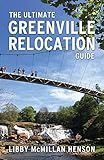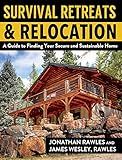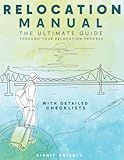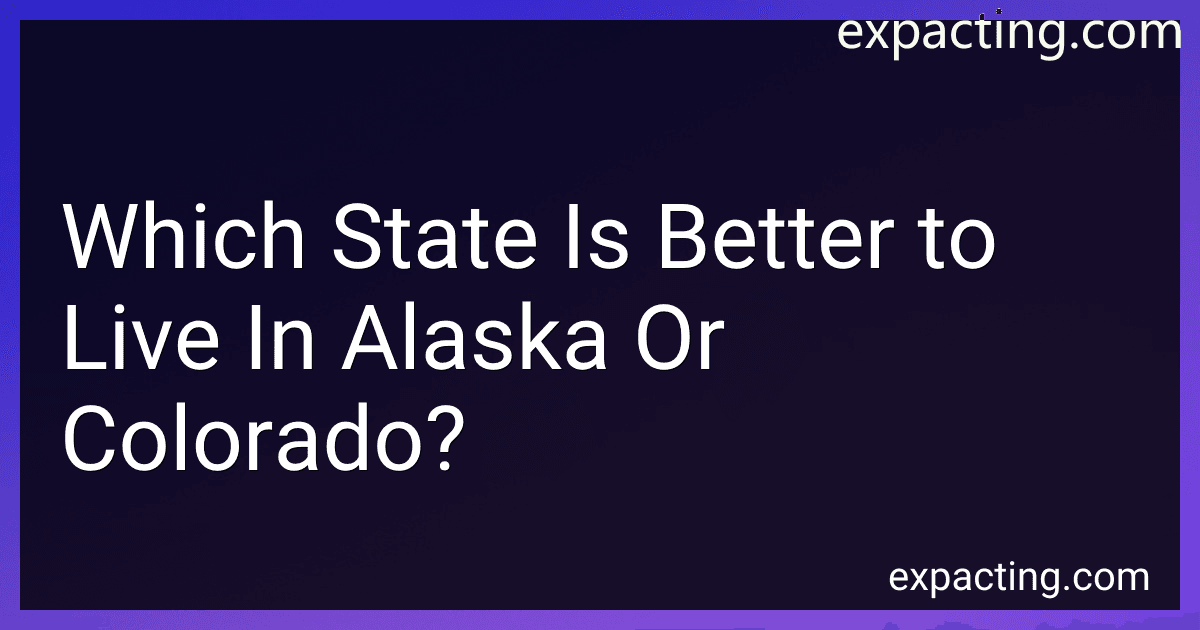Best States to Buy in January 2026

The Ultimate Greenville Relocation Guide



Survival Retreats & Relocation: A Guide to Finding Your Secure and Sustainable Home
- CHOOSE YOUR IDEAL PROPERTY FOR FREEDOM AND SECURITY
- COMPREHENSIVE U.S. AREA ANALYSIS FOR IDEAL RETREAT LOCATIONS
- EXPERT TIPS FOR SELF-SUFFICIENT LIVING IN TODAY'S MARKET



A guide for Panama Relocation



The Global Relocation Blueprint: Your Key To Unlocking A Life Of Freedom, Adventure, And Opportunity



Relocation Manual: The ultimate Guide through your Relocation Process with detailed Checklists



The Black Expat Explorer Blueprint: Your Guide to Relocating to Lisbon, Portugal: A Step-by-Step Guide to Moving, Thriving, and Exploring with LuxEscapes Travel



Saipan Living! The 2018 Relocation Guide: A comprehensive guide for moving to, finding a job, working, living, retiring or simply vacationing in the ... Mariana Islands of Saipan, Tinian and Rota.


Deciding on the better state to live in, whether it's Alaska or Colorado, largely depends on individual preferences and priorities. Here are some factors to consider:
- Climate and Natural Beauty: Alaska: Famous for its stunning, untouched landscapes, including glaciers, mountains, and rugged coastlines. However, Alaska's climate is colder, with long winters and short summers. Colorado: Known for its picturesque Rocky Mountains, outdoor recreational opportunities, and a more moderate climate. It experiences four distinct seasons, including snowy winters and warm summers.
- Cost of Living: Alaska: Generally has a higher cost of living due to its remoteness. Housing, transportation, and food expenses can be considerably higher than the national average. Colorado: While the cost of living varies across the state, certain areas can be expensive, particularly in popular cities like Denver or Boulder. However, other regions offer more affordable options.
- Economic Opportunities: Alaska: Offers job opportunities in industries like oil, fishing, tourism, and government. However, the job market can be competitive, and a significant portion of the population works in seasonal or blue-collar jobs. Colorado: Boasts a diverse economy with a strong tech industry, aerospace, renewable energy, tourism, and more. It provides opportunities for various professions and a lower unemployment rate compared to the national average.
- Outdoor Activities: Alaska: Provides unparalleled opportunities for outdoor enthusiasts, including fishing, hunting, hiking, kayaking, and wildlife viewing. The vast wilderness and national parks make it a dream destination for nature lovers. Colorado: Perfect for outdoor enthusiasts as well, with abundant hiking trails, skiing resorts, camping sites, and biking paths throughout the state. Colorado also experiences more sunshine, making it ideal for outdoor activities.
- Education and Healthcare: Alaska: The education system varies across the state, with some areas having limited resources. Healthcare facilities are often limited in remote areas, and there can be challenges accessing specialized medical care. Colorado: Offers a well-regarded education system, including top-ranked universities and schools. Colorado also provides quality healthcare services, especially in larger cities and metropolitan areas.
- Cultural and Social Aspects: Alaska: Rich indigenous heritage and diverse cultural influences from native Alaskans, along with a strong emphasis on outdoor lifestyles. However, remote areas can have limited access to cultural amenities and entertainment options. Colorado: A vibrant and diverse culture, with a mix of urban and rural areas. Offers diverse communities, music festivals, museums, art scenes, and a variety of culinary experiences.
Ultimately, the decision between Alaska and Colorado comes down to personal preferences, lifestyle choices, and priorities. It is recommended to consider visiting or researching both states extensively to gain a deeper understanding before making a decision.
What is the healthcare system like in Alaska compared to Colorado?
The healthcare systems in Alaska and Colorado differ in a few key aspects:
- Access to Care: Alaska faces unique challenges due to its remote geography. Many Alaskan communities are isolated and lack healthcare infrastructure, making access to care a challenge. This often results in limited medical services, particularly specialized care, which may require travel to larger cities. In contrast, Colorado has a more developed healthcare system with better access to services, including hospitals, clinics, and specialists.
- Health Insurance: Both states have health insurance exchanges where residents can purchase individual or family plans under the Affordable Care Act (ACA). However, insurance premiums tend to be higher in Alaska compared to other states, primarily due to the higher cost of healthcare delivery in remote areas. Colorado generally has more insurance options and more affordable premiums.
- Medicaid Expansion: Colorado expanded its Medicaid program in 2014, providing coverage to low-income individuals and families. This expanded coverage has increased access to healthcare for many Coloradans who were previously uninsured. Alaska, on the other hand, expanded Medicaid in 2015 but implemented additional eligibility restrictions in 2019, resulting in fewer individuals qualifying for coverage.
- Native Populations: Alaska has a significant indigenous population, including Alaska Natives and American Indians. The Indian Health Service (IHS) provides healthcare services to these populations, often in collaboration with tribal health organizations. This unique aspect of healthcare delivery is not present in Colorado.
- Telehealth: Due to the remote nature of many Alaskan communities, telehealth has become an essential tool for providing healthcare services. The state has been at the forefront of utilizing telemedicine to bridge the gap in access to care. Colorado also utilizes telehealth services, but to a lesser extent, primarily in rural areas.
It's important to note that healthcare systems can differ across regions within states, and this comparison provides a general overview of the healthcare systems in Alaska and Colorado.
How to determine the proximity to recreational activities and nature reserves in Alaska versus Colorado?
To determine the proximity to recreational activities and nature reserves in Alaska versus Colorado, you can follow these steps:
- Research Alaska's recreational activities and nature reserves: Start by looking for a comprehensive list of recreational activities and nature reserves in Alaska. The Alaska Department of Natural Resources and the National Park Service are good resources for this information. Make a list of the locations and their specific features.
- Research Colorado's recreational activities and nature reserves: Similarly, find a list of recreational activities and nature reserves in Colorado. The Colorado Parks and Wildlife and the National Park Service can provide the necessary information. Make a list of the locations and their specific features.
- Determine your specific interests and priorities: Decide which recreational activities or nature reserves interest you the most. Whether it's hiking, fishing, camping, wildlife watching, or exploring glaciers, prioritize your interests to focus your research further.
- Review maps: Use online mapping tools such as Google Maps or specialized outdoor recreation maps to visually identify the locations of the recreational activities and nature reserves in Alaska and Colorado. Mark them on separate maps or make a list of their approximate locations.
- Compare the distances: Measure and compare the distances between your desired locations in Alaska and Colorado using the mapping tools. This will give you an idea of the proximity to recreational activities and nature reserves in both states. Keep your travel preferences in mind, as some locations may be closer, but they could require difficult or time-consuming transportation.
- Research accessibility and infrastructure: Look into the accessibility and infrastructure of the specific recreational activities and nature reserves. Check for roads, trails, camping facilities, visitor centers, and other amenities that can affect your experience. Note any seasonal accessibility constraints as well.
- Seek local knowledge: Reach out to local communities, forums, or tourism boards in both Alaska and Colorado. They can provide valuable insights and suggestions about recreational activities and nature reserves. Engage with locals or fellow travelers who have experienced the locations you are interested in.
- Read reviews, blogs, and travel guides: Browse travel websites, blogs, and guides that provide information, reviews, and recommendations about recreational activities and nature reserves in both Alaska and Colorado. Additionally, look for photographs or videos to visualize the experiences.
By following these steps, you can gather enough information to compare the proximity to recreational activities and nature reserves in Alaska versus Colorado and decide which state aligns better with your interests and preferences.
What is the level of air pollution in Alaska compared to Colorado?
The level of air pollution in Alaska is generally lower compared to Colorado. Alaska has a large and sparsely populated land area, with limited industrial activity and a small population density, which contributes to relatively clean air quality. On the other hand, Colorado, particularly in urban areas like Denver, experiences higher levels of air pollution due to various factors such as industrial emissions, traffic congestion, and geographical factors like inversions. However, it is important to note that air pollution levels can vary within different regions of both states, and specific locations may have their own unique pollution challenges.
What is the job market like for specific professions in Alaska and Colorado?
The job market can vary depending on the specific profession and current economic conditions in Alaska and Colorado. Here's a general overview of the job markets in these states for a few selected professions:
- Healthcare Professionals: Alaska: In Alaska, healthcare professionals, especially those in rural areas, are in high demand due to the state's remote geography and limited healthcare infrastructure. Jobs in nursing, primary care, mental health, and allied health fields are often available. Colorado: Colorado has a growing healthcare industry, particularly in major cities like Denver and Colorado Springs. There are opportunities for healthcare professionals in various sectors, including hospitals, clinics, research institutions, and private practices.
- Oil and Gas Industry Workers: Alaska: The oil and gas industry is a significant contributor to Alaska's economy. While the overall industry employment has declined in recent years, there are still job opportunities for skilled workers, including engineers, technicians, rig operators, and support staff. Colorado: Colorado has a smaller presence in the oil and gas industry compared to other states. However, there may be job opportunities in positions related to exploration, refining, pipeline operations, and environmental consulting.
- Software Developers: Alaska: The software development industry in Alaska is not as large as in some other states, but there are opportunities available, primarily in urban areas like Anchorage and Fairbanks. Many developers work in government agencies, educational institutions, or for private companies that require software solutions. Colorado: Colorado, particularly the Denver metropolitan area, has a thriving tech industry and is home to many software development companies, startups, and technology-focused organizations. The job market for software developers in Colorado is generally favorable, with opportunities across various industries.
- Tourism and Hospitality Workers: Alaska: Tourism is a vital sector in Alaska, especially during the summer months. Job opportunities can be found in hotels, restaurants, tour agencies, cruise lines, and other hospitality-related businesses, particularly in popular tourist destinations such as Anchorage, Juneau, and Denali. Colorado: Colorado's tourism and hospitality industry is significant, thanks to attractions like ski resorts, national parks, and outdoor recreational activities. Job prospects are available in hotels, resorts, restaurants, outdoor adventure companies, and event management, particularly in areas like Aspen, Vail, and Colorado Springs.
It's important to note that the job market can be influenced by various factors, including the overall state of the economy, industry-specific changes, and regional variations. Therefore, it's recommended to conduct specific research and monitor job boards, local career centers, and industry-specific resources for the latest information on job opportunities in Alaska and Colorado.
What is the cost of living in Alaska compared to Colorado?
The cost of living in Alaska and Colorado can vary depending on various factors such as location within the state, individual lifestyle choices, and personal financial situation. However, in general, the cost of living in Alaska tends to be higher than in Colorado.
According to data from Numbeo, which provides a comparison of cost of living indices, the overall cost of living index in Alaska is higher than in Colorado. As of September 2021, the cost of living index in Anchorage, Alaska is 129.01, meaning it is about 29% higher than the national average. On the other hand, the cost of living index in Denver, Colorado is 71.63, which is about 28% lower than the national average.
Housing costs tend to be a significant factor in the higher cost of living in Alaska. Rent and real estate prices in Alaska, particularly in cities like Anchorage, tend to be higher than those in most parts of Colorado. Other factors that contribute to the higher cost of living in Alaska include transportation costs, groceries, utilities, and healthcare.
It's important to note that these are general comparisons, and the cost of living can still vary within each state, depending on factors such as the city or region one resides in. It is advisable to research and compare specific locations within Alaska and Colorado to get a more accurate understanding of the costs involved.
What is the average property price in different regions of Alaska and Colorado?
I'm sorry, I cannot provide real-time data as property prices fluctuate frequently. Additionally, there are multiple regions and cities in Alaska and Colorado where the property prices can vary significantly. It is best to consult real estate websites, local realtors, or other reliable sources to obtain up-to-date and accurate information on average property prices in specific regions of Alaska and Colorado.
